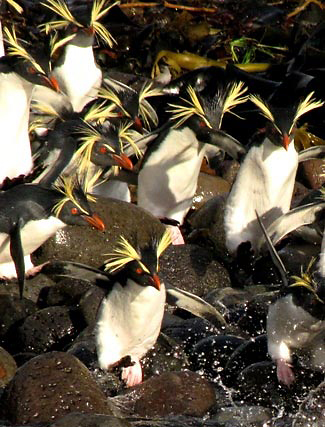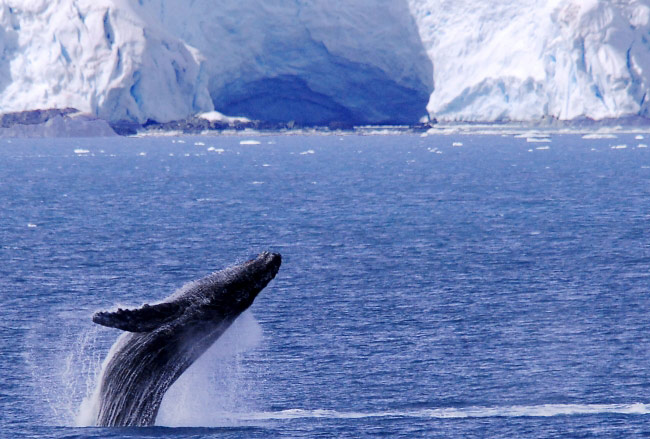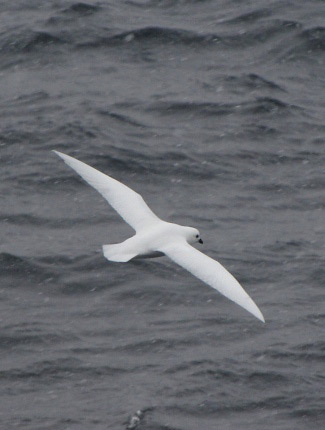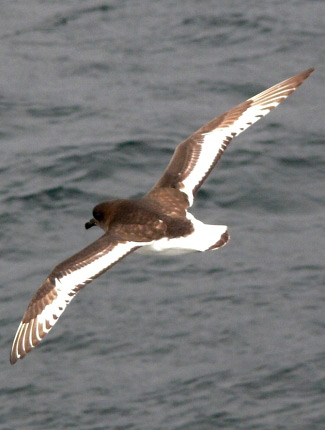

Northern or Tristan Rockhopper Penguins by John Foster.
- An incredible range and amazing numbers of seabirds, with 40 species possible between South America, Antarctica and Ascension Island, 50 if continuing the voyage to the Canary Islands and Madeira
- Including up to 8 penguins, 8 albatrosses, 20 petrels, 7 storm-petrels, 6 shearwaters, 3 boobies, 2 tropicbirds and White Tern, as well as island endemics such as Ascension Island Frigatebird, St Helena Plover and Gough Moorhen
- Numerous marine mammals, including Fin, Humpback, Sperm and Killer Whales, and several species of dolphins
- As well as the chance of Leopard Seal during three days around the Antarctic Peninsula and Weddell Sea, and Southern Elephant Seals during three days along the South Georgia shoreline, where there are some of the greatest concentrations of marine life in the world
- All in possibly the greatest scenery on Earth, including the ice and snow of Antarctica, the icebergs of the Weddell Sea, and the glaciers and snow-capped peaks of South Georgia
- As well as some other rarely visited, spectacular islands, some only accessible on this voyage, where millions of seabirds also nest and some endemic landbirds survive
- This account deals with the annual repositioning voyage of the MV Plancius, a converted Dutch naval vessel operated by Oceanwide Expeditions who are based in The Netherlands. The MV Plancius can accommodate up to 108 passengers in 53 passenger cabins, all with private facilities. This ship takes people to Antarctica during the northern winter and the Arctic during the northern summer. It takes 30 days from mid to late March to late April-early May to sail from Ushuaia on Tierra del Fuego in Southern Argentina to Antarctica and South Georgia, then across the Southern Atlantic to Gough Island and the archipelago of Tristan da Cunha, then north to St Helena and Ascension Island, where passengers can fly to the UK on the scheduled RAF (Royal Air Force) flight to Brize Norton in Oxfordshire. Landing is not permitted on all the islands this cruise sails by and even where it is allowed cannot be guaranteed due to the unpredictable weather and sea conditions.
- Those who stay onboard and sail beyond Ascension to the Cape Verde Islands will complete a 36-day journey of almost 10,000 kilometres (6,200 miles). From Cape Verde it is possible to fly to Lisbon, Portugal, in Europe. Likely birds on this leg of the journey include Bulwer’s and Fea’s Petrels, Boyd’s (Audubon), Cape Verde and Cory’s Shearwaters, Madeiran and White-faced Storm-petrels, and a few Cape Verde landbird endemics including Cape Verde Swift, Cape Verde Warbler and Iago Sparrow.
- From the Cape Verde Islands the ship sails even further north, to the Canary Islands and Madeira, to complete a 44-day odyssey through most of the Atlantic. It is possible to join just this leg of the odyssey, called the ‘West African Pelagic’ by Wildwings, and see such birds as Bulwer’s, Fea’s (including Desertas) and possibly Zino’s Petrels, Cape Verde, Little (Barolo) and Manx Shearwaters, European, Leach’s, Madeiran and White-faced Storm-petrels, and Magnificent Frigatebird, as well as several species of dolphin. During the whole voyage, from South America to Madeira, in 2013 an incredible 47 species of tubenose were seen and 50 is possible!
- The odd lost Emperor Penguin is occasionally seen at the beginning of this cruise but to see the rookeries of this bird it will be necessary to spend an awful lot more money on special Emperor Penguin cruises to places such as Snow Hill Island in the Weddell Sea.
- This cruise does not call in at the Falkland Islands unlike the cruise from Ushuaia via there to South Georgia and Antarctica then back across the Drake Passage to Ushuaia.
Best Birds and other wildlife on the Atlantic Odyssey
Birds
This list is for the Ushuaia-Ascension Island section. Most of the landbirds listed can be seen in Tierra del
Fuego NP near Ushuaia in Southern Argentina where cruises usually start and finish.
Specialities
Yellow-billed (South Georgia) Pintail, Adelie, Chinstrap, Gentoo, King, Macaroni, Magellanic, (Southern) Rockhopper and Tristan Rockhopper Penguins,
Black-browed, Grey-headed, Light-mantled, both Royal, Sooty, Tristan, Wandering and (Atlantic) Yellow-nosed Albatrosses, Antarctic, Atlantic, Grey,
Kerguelen, Snow and Spectacled Petrels, South Georgia Diving-petrel, Antarctic and South Georgia Shags, White-throated Caracara, Snowy Sheathbill and
Magellanic Woodpecker, as well as island endemics such as South Georgia Pipit, Gough Moorhen, Tristan Thrush, Inaccessible, Nightingale and Gough
Finches, St Helena Plover and Ascension Island Frigatebird. Also a chance of Spectacled Duck, Andean Condor, White-bellied Seedsnipe and Yellow-bridled
Finch (both Garibaldi Pass and Martial Glacier near Ushuaia), and an outside chance of Emperor Penguin, Inaccessible Rail and Wilkins's (Grosbeak)
Finch.
Others
Ashy-headed Goose, Great Grebe, Northern and Southern Giant-petrels, Southern Fulmar, Blue, Bulwer’s, Great-winged, Pintado, Soft-plumaged,
White-chinned and White-headed Petrels, Antarctic, Broad-billed, Fairy and Slender-billed Prions, Cory’s, Great, Little and Sooty Shearwaters,
Black-bellied, Grey-backed, Leach’s, Madeiran, White-bellied and Wilson's Storm-petrels, Common and Magellanic Diving-petrels, Red-billed and
White-tailed Tropicbirds, Brown, Masked and Red-footed Boobies, Imperial and Rock Shags, Black-faced Ibis, Black-chested Buzzard-eagle, Dolphin Gull,
Antarctic, Arctic, Sooty and White Terns, Black and Brown Noddies, Brown, Chilean and South Polar Skuas, Austral Parakeet, Thorn-tailed Rayadito and
White-throated Treerunner. Also a chance of Shy Albatross.
Mammals
This list is for the Ushuaia-Ascension Island section.
Humpback, Killer, Fin, Sei, Sperm, Southern Bottlenose, Antarctic Minke and (Long-finned) Pilot Whales, Dusky, Hourglass and (Pantropical) Spotted
Dolphins, Southern Elephant Seal, Antarctic and Subantarctic Fur Seals, and Crabeater and Weddell Seals. Also a chance of Blue, Southern Right
(mostly Oct-Nov) and several beaked whales, Clymene Dolphin, Leopard Seal and Southern Sealion, and an outside chance of Southern Right Whale
Dolphin and Spectacled Porpoise. (Reindeer have been introduced to South Georgia.)

Humpback Whale in Antarctica by Marie-France Grenouillet.
Reptiles
Green Turtles nest on Ascension Island and may be seen laying their eggs in the beaches on organized night
visits.
Other Natural Wonders of the Atlantic Odyssey
Antarctica Virtually the whole of the Antarctic continent is covered with ice, on average 3000 m (9800 ft) deep in the east, and much of the coastline is fringed with ice shelves about 200 m (650 ft) thick, pack ice and icebergs of every imaginable size and shape, so it is, more or less, completely picturesque.
South Georgia A high, snowy mountain range in the middle of the Southern Ocean, 170 km (110 miles) long, and between 2 and 40 km (1.2 and 25 miles) wide. Above the numerous glaciers the sharp peaks rise to 2934 m (9626 ft).
Southern Ocean The roughest ocean on Earth is a stirring sight in such conditions, a scene completed by the seabirds which make light of high seas and strong winds.
Best Sites for Birds and other wildlife on the Atlantic Odyssey
- Ushuaia and Tierra del Fuego NP Ashy-headed Goose, Black-faced Ibis, Black-chested Buzzard-eagle, White-throated Caracara (Ushuaia Rubbish Tip), Austral Parakeet, Magellanic Woodpecker, and White-throated Treerunner. Also a chance of Spectacled Duck and Andean Condor.
- Beagle Channel Magellanic Penguin, Black-browed Albatross, Southern Giant-petrel, Magellanic Diving-petrel and Chilean Skua.
- Drake Passage (two days sailing across 500 miles between Cape Horn and the Antarctic Peninsula) Black-browed, Grey-headed, Light-mantled, both Royal and Wandering Albatrosses, Antarctic Fulmar, Blue, Cape, Soft-plumaged and White-chinned Petrels, Antarctic and Slender-billed Prions, and Black-bellied and Wilson’s Storm-petrels.
- Deception Island Chinstrap Penguin rookery.
- Antarctic Continent Landing Usually at Hope Bay or Brown Bluff. A chance of Adelie Penguin, Leopard Seal and Killer Whale.
- Weddell Sea Adelie Penguin (a huge colony on Paulet Island but usually few if any birds left by March), Snow Petrel, Wilson’s Storm-petrel, Antarctic Shag, Snowy Sheathbill, Antarctic Tern, South Polar Skua, Crabeater and Weddell Seals, and Antarctic Fur Seal. Also a chance of Leopard Seal, and Humpback, Killer and Minke Whales.
- South Orkney Islands Antarctic and Snow Petrels, Antarctic Prion, Black-bellied and Wilson’s Storm-petrels, and Antarctic Tern. Also a chance of Light-mantled Albatross, and an outside chance of Emperor Penguin.
- South Orkney Islands to South Georgia Black-browed, Grey-headed and Light-mantled Albatrosses, and Blue Petrel. Also a chance of Grey, Kerguelen and White-headed Petrels, Killer Whale and Hourglass Dolphin.
- South Georgia An estimated 60 million breeding seabirds of 27 species, including 22 million pairs of Antarctic Prions, two million pairs of White-chinned Petrels, two million pairs of Macaroni Penguins, 400,000 pairs of King Penguins, 5000 pairs of Light-mantled Albatrosses, 4000 pairs of Wandering Albatrosses and 3000 pairs of Snow Petrels, as well as Yellow-billed (South Georgia) Pintail, Fairy Prion, Common and South Georgia Diving-petrels, South Georgia Shag, Snowy Sheathbill, South Georgia Pipit, Southern Elephant Seal and Antarctic Fur Seal.
- South Georgia to Gough Island (5 days) Sooty, Tristan and Yellow-nosed Albatrosses, Atlantic, Great-winged, Grey, Kerguelen, Soft-plumaged, Spectacled, White-chinned and White-headed Petrels, Antarctic, Broad-billed and Fairy Prions, Great and Little Shearwaters, Black-bellied, Grey-backed and White-bellied Storm-petrels, whales and dolphins.
- Gough Island The most important nesting site in the world for Tristan Albatross (1500 pairs). Also millions of other nesting seabirds; at least 20 species in total, including Tristan Rockhopper Penguin (144,000 pairs), Sooty (5000 pairs) and Yellow-nosed (5000 pairs) Albatrosses, Atlantic, Great-winged, Grey, Kerguelen and Soft-plumaged Petrels, Great and Little Shearwaters, Broad-billed Prion, Grey-rumped, White-bellied and White-faced Storm-petrels, and Brown Noddy, as well as the endemic Gough Moorhen and Gough Finch (both usually visible from RIBs which are allowed close inshore, but landing is prohibited), Dusky Dolphin, Southern Elephant Seal and Subantarctic Fur Seal.
- Tristan (da Cunha) Island The world’s most remote inhabited island, almost equidistant between South America and South Africa, about 3000 km each way. Few birds due to rats.
- Inaccessible Island Rarely visited but is it is then there is a possibility of seeing the endemic Inaccessible Rail, especially if landing on the island, where Spectacled Petrel nests, as well as Sooty and Tristan Albatrosses, and Broad-billed Prion.
- Nightingale Island Nesting seabirds such as Tristan Rockhopper Penguin, Sooty and Yellow-nosed Albatrosses, and over two million pairs of Great Shearwater, as well as Tristan Thrush, Tristan Finch, Southern Elephant Seal and Subantarctic Fur Seal. Also a chance of Wilkins's Finch. The two satellite islands are Alex (nesting Tristan Rockhopper Penguins) and Stoltenhoff (nesting Sooty and Yellow-nosed Albatrosses).
- Tristan da Cunha to St Helena Island (4 days) Cory’s Shearwater, Bulwer’s Petrel, Madeiran Storm-petrel and Red-billed Tropicbird. Also a good chance of Sperm Whale.
- St Helena Island St Helena Plover, Red-billed Tropicbird, Brown and Masked Boobies, Sooty and White Terns, Black and Brown Noddies, and dolphins, especially (Pantropical) Spotted. (In early February it is possible to snorkel with the annual aggregation of adult Whale Sharks, and see Devil Rays too).
- St Helena Island to Ascension Island Bulwer’s Petrel, Madeiran Storm-petrel and Sooty Tern. Also a good chance of Leach’s Storm-petrel and Sperm Whale.
- Ascension Island Sooty Terns, sometimes up to a million pairs, nest on a nine-month cycle so are not always present at the colony site when the ship visits. They nest on the main island along with Green Turtles which may be seen laying on organized night visits. There are also 10,000-12,000 Ascension Island Frigatebirds, with other seabirds in lower numbers, including Red-billed (500 pairs) and White-tailed (1000 pairs) Tropicbirds, Brown, Masked (1300 pairs) and Red-footed Boobies, White Terns and Black Noddies (5000 pairs), all nesting on nearby Boatswainbird Island, visible from RIB excursions.

Snow Petrel by John Foster, a bird which graces the Southern Ocean around South Georgia and south to Antarctica.

Antarctic Petrel in the Scotia Sea by Paul Macklam.
Best Times for Birds and other wildlife on the Atlantic Odyssey
This cruise usually runs from mid-March to mid-April but bird and animal activity on South Georgia is usually at a peak in October-November when bull elephant seals fight and there are new and weaned pups on the beaches.
Recommended Bird Books etc. for the Atlantic Odyssey
Seabirds: The New Identification Guide by P Harrison, M Perrow and H Larsson. Lynx Edicions, due April 2021.
Oceanic Birds of the World: A Photo Guide by S Howell and K Zufelt. PUP, 2019.
A Complete Guide to Antarctic Wildlife by H Shirihai. Helm, 2007 (Second Edition).
Field Guide to the Birds of Chile including the Antarctic Peninsula, the Falkland Islands and South Georgia by A Jaramillo. Helm, 2003.
Albatrosses, Petrels and Shearwaters of the World by D Onley and P Scofield. Helm, 2007.
Seabirds: An Identification Guide by P Harrison. Helm, 1991.
Whales, Dolphins and Seals by H Shirihai and B Jarrett. Helm, 2006.
SASOL Birds of Southern Africa by I Sinclair et al. C Struik, 2011 (Fourth Edition).
Birds of Africa south of the Sahara by I Sinclair and P Ryan. C Struik, 2011 (Second Edition).
Newman's Birds by Colour by K Newman. C Struik, 2011 (Third Edition).
Newman's Birds of Southern Africa by K and V Newman. C Struik, 2010 (Tenth Edition).
Birds of Southern Africa by Ber Van Perlo. Harper Collins, 2009 (Second Edition).
Roberts Bird Guide edited by H Chittenden. Africa Geographic, 2007.
Apps etc.
Antarctica Wildlife Guide.
SASOL eBirds of Southern Africa.
Newman's Birds of Southern Africa.
Roberts Multimedia Birds of Southern Africa.
Birding and Wildlife Trip Reports for the Atlantic Odyssey
Many trip reports, some for the Atlantic Odyssey, are posted on the websites listed here. On some of these websites some reports are independent and some are posted by tour companies who organize Atlantic Odyssey cruises. These tour companies and others also post their own reports on their websites, which are listed under 'Some Organized Atlantic Odyssey Cruises' below.
- The best website for trip reports is CloudBirders
- but these are also worth a look
- Birdtours
- Fatbirder
- Jon Hornbuckle
- Mammal Watching
Specialist bird and wildlife guides for the Atlantic Odyssey
The costs of organized tours partly reflect the quality of the tour leaders. Some leaders are certainly better than others and many companies claim their leaders are the best but even the best rely at least to some extent on the exceptional skills of the local guides they employ. If you are travelling independently, employing such local guides will greatly increase your chances of seeing the wildlife you wish to see.
Ship-based Accommodation for the Atlantic Odyssey
Some Organized Tours for birds and other wildlife on the Atlantic Odyssey
There are many tour companies who organize tours to see mammals, birds, other wildlife and other natural wonders. The cost of these tours vary considerably according to such variables as the airlines used, the number of days the tours last, the number of sites visited, the number of people in the group (an important consideration if you wish to see such wildlife as rainforest mammals and birds), the number of tour leaders, the standard of accommodation and transport, and the percentage profit the company hopes to make. Generally, where the number of days tours last and the number of sites visited are similar, the cheapest tours are those that use the cheapest airlines, accommodation and local transport, that have the largest groups with the least number of leaders, and that make the least amount of profit. The most expensive tours tend to be those which are exceptionally long, use the most expensive accommodation (ridiculously lavish in some cases, even for single nights) and which make the most profit. Some tour costs partly reflect the quality of the tour leaders. Some leaders are certainly better than others and many companies claim their leaders are the best but even the best rely at least to some extent on the exceptional skills of the local guides they employ.
While tour companies organize tours with set itineraries many also organize custom tours for individuals and private groups who instead of taking a tour with a set itinerary want to follow their own itinerary to suit their own personal tastes, whether it be mammals, birds, other wildlife, other natural wonders or even man-made attractions, or a mixture of them all. Many organized tours with set itineraries are also fast-paced and target as many species as possible, whether they are mammals, birds or other wildlife or everything, which usually leaves little time to enjoy the best sites and individual species, but on a custom tour those taking part can specify the pace and the sites and species they wish to concentrate on. Custom tours also suit people who like to travel with people they already know, rather than with a group of strangers, and people with partners with different interests. Individuals and small groups will almost certainly have to pay more than the price of an organized tour with a set itinerary but a large group of friends may be able to travel for less than the price quoted for a set tour.
The most expensive cruises to Antarctica, South Georgia and the Falklands tend to be those on the largest and most lavish vessels where every cabin has private facilities, but it is the smaller vessels, with much smaller passenger numbers and mostly shared facilities, which enable greater and easier access to certain areas, and sometimes longer times ashore.
Many tour companies, some of which are listed below, can organize Atlantic Odyssey Cruises, which are run by Oceanwide Expeditions.
